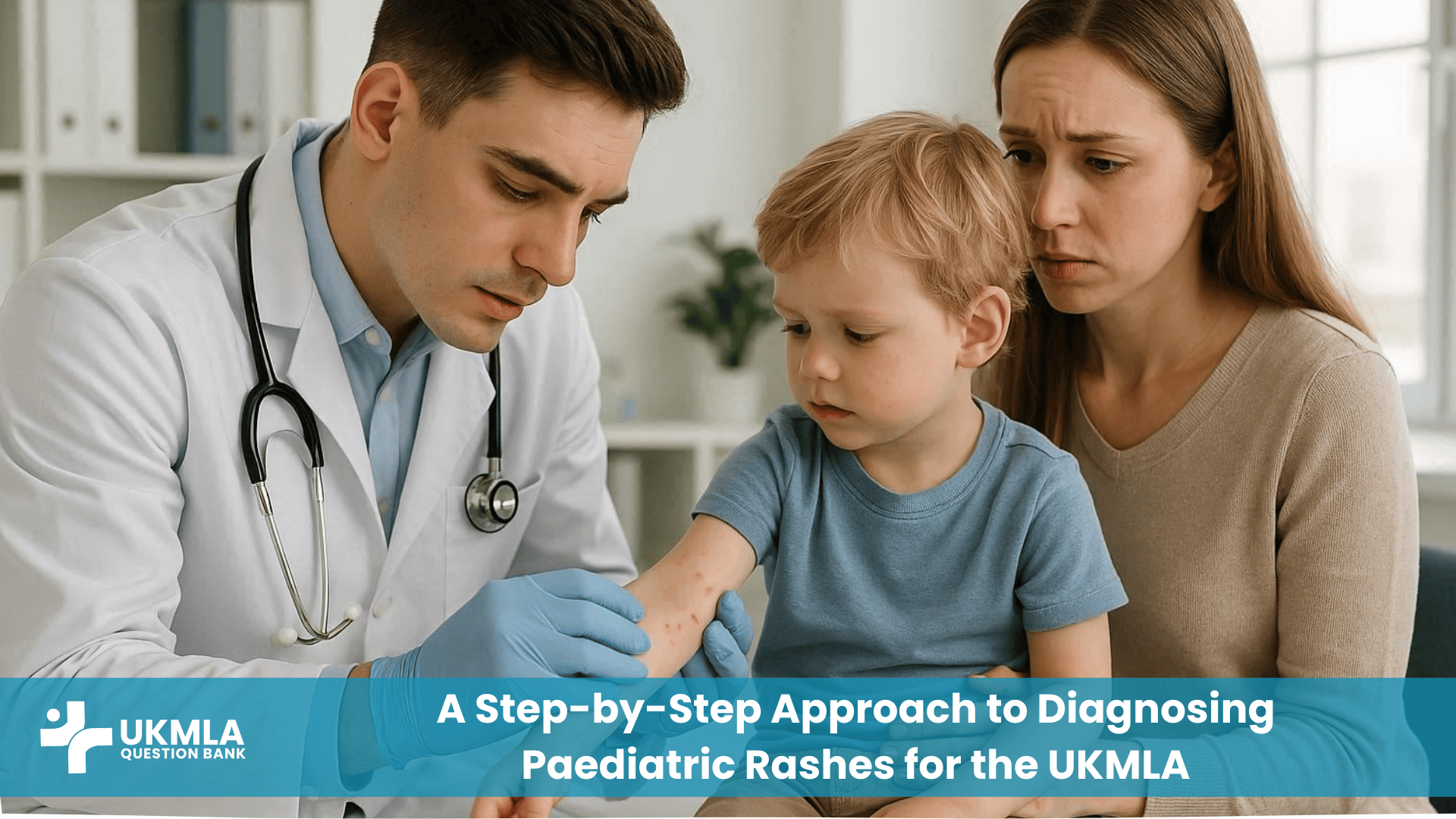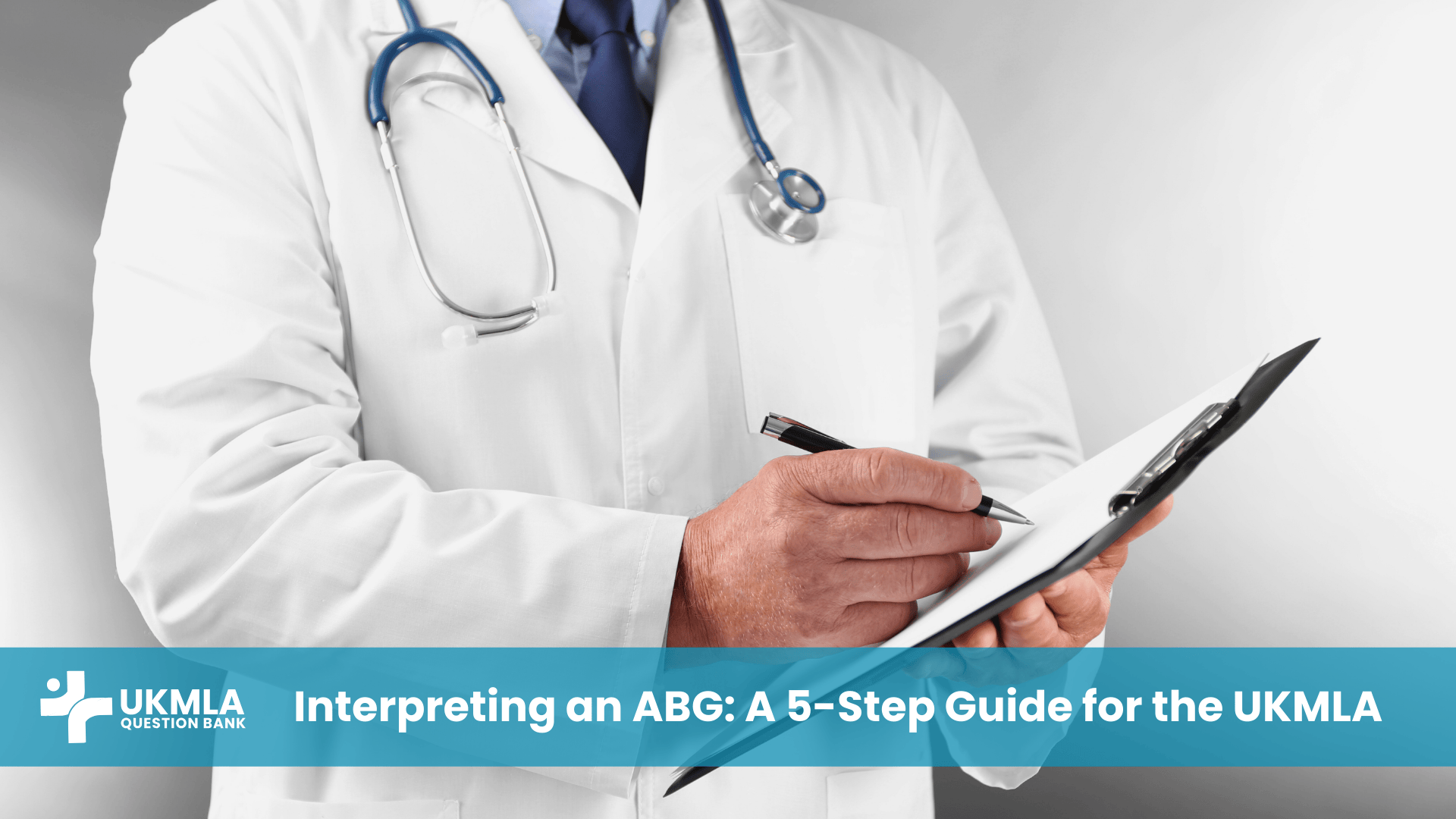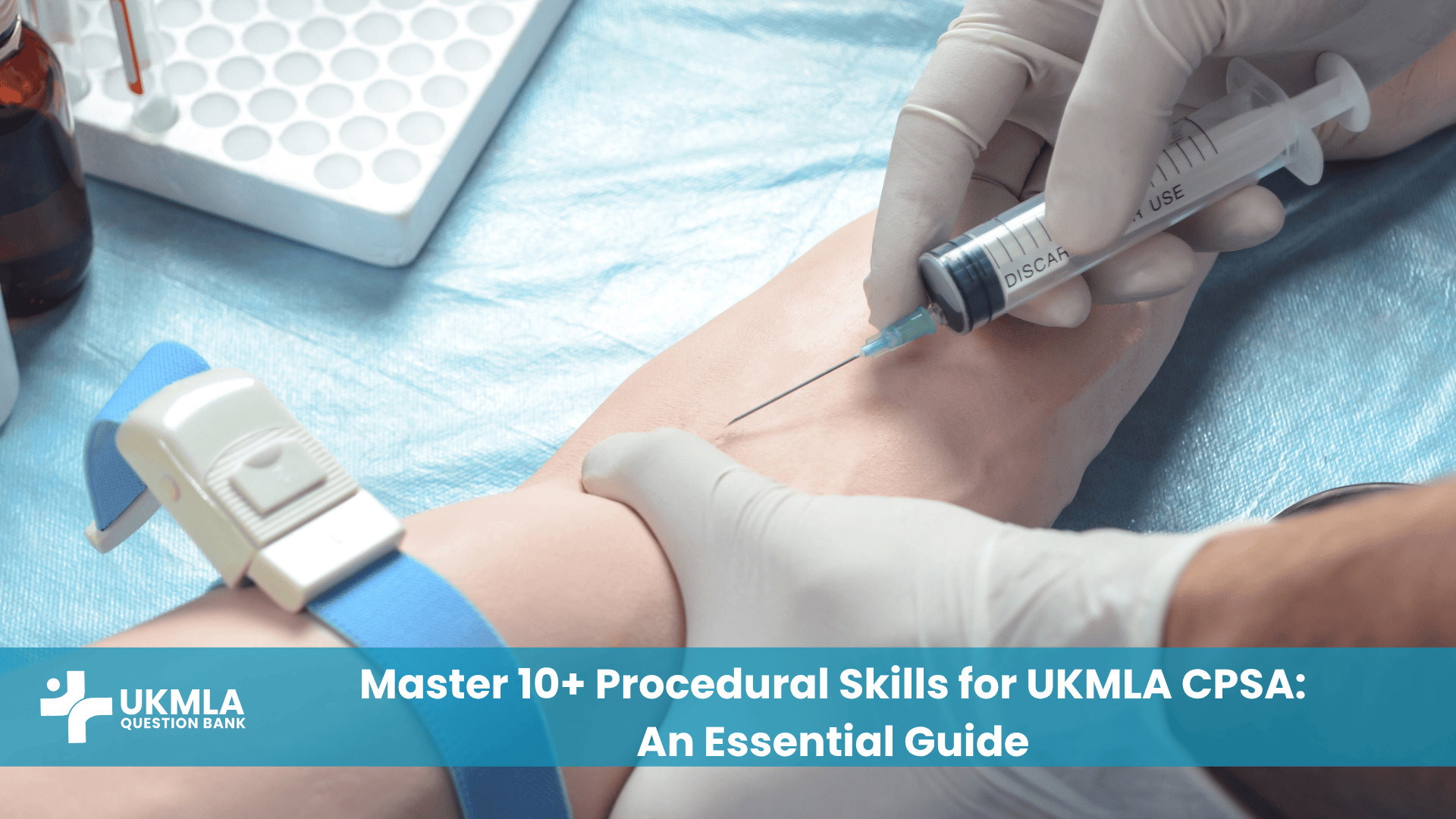Introduction
Differentiating between common paediatric rashes UKMLA candidates will encounter is a high-yield skill that sits at the intersection of several specialties and is a core part of the Paediatrics Essentials for UKMLA. A child with a new rash is one of the most frequent presentations in general practice and the emergency department, often causing significant anxiety for parents. The core clinical challenge lies in rapidly distinguishing between the vast majority of benign, self-limiting viral exanthems and the rare but life-threatening conditions, such as meningococcal septicaemia, that require immediate, life-saving intervention.
This guide is designed to provide a clear, structured framework for approaching this common and critical clinical scenario. We will first establish a systematic approach to any paediatric rash, covering the essential history and examination findings. We will then take a deep dive into the five key rashes you must be able to conquer for your UKMLA exams, detailing their hallmark features. Finally, we will cover the absolute can’t-miss red flag rashes, ensuring you have the knowledge to act decisively when it matters most. For a helpful visual overview, the NHS website on ‘Rashes in babies and children’ is also an excellent resource.
Table of Contents
ToggleA Framework for Approaching Any Paediatric Rash
Before you can identify a specific rash, you need a systematic approach to gathering information. A rushed or unstructured assessment can lead to diagnostic errors.
The History: Key Questions to Ask
A thorough history from the parent or carer is the most valuable diagnostic tool you have. It provides the context needed to interpret the physical findings. For a comprehensive overview of consultation skills, review our guide on history taking in the CPSA.
Prodrome: Ask about symptoms that occurred before the rash appeared. A history of fever, cough, coryza (runny nose), and conjunctivitis (the “3 Cs”) is a classic clue for measles.
Immunisation Status: This is a non-negotiable question. “Are the child’s immunisations fully up to date?” A child who is not vaccinated against MMR is at a much higher risk for measles.
Contacts: “Is the child in nursery or school?” “Have they been in contact with anyone who has been unwell or had a similar rash recently?” This can provide vital clues for infectious causes like chickenpox.
Systemic Symptoms: This is your assessment of how unwell the child is. Are they eating and drinking normally? Are they passing urine (a key sign of hydration)? Are they alert and playful, or are they drowsy and irritable? A systemically unwell child with a rash is a major red flag.
The Examination: How to Describe a Rash
Being able to accurately describe a rash is a core clinical skill. Your description should be precise and use correct terminology.
Distribution: Where on the body is the rash? Where did it start, and where did it spread? A rash that starts behind the ears and spreads downwards (cranial-caudal spread) is typical of measles. A rash concentrated on the palms and soles should make you think of Hand, Foot, and Mouth Disease.
Morphology: What does the lesion itself look like?
Macule: A flat area of colour change.
Papule: A small, raised palpable lesion. A rash that is both macular and papular is called maculopapular.
Vesicle: A small, raised, fluid-filled blister (e.g., chickenpox).
Petechiae: Tiny, non-blanching red/purple spots caused by intradermal bleeding.
Purpura: Larger, non-blanching purple lesions. Both petechiae and purpura are red flags.
Conquer the 5 Key Common Paediatric Rashes UKMLA Requires
While countless viruses can cause childhood rashes, the UKMLA will focus on the classic, high-yield presentations. Mastering these five will cover the majority of what you need to know.
1. Measles (Rubeola)
The Basics: Caused by the measles virus, this is a highly contagious and notifiable disease. It is now less common due to the MMR vaccine but can occur in unvaccinated individuals.
Key Identifiers: Look for the classic prodrome of the 3 C’s (Cough, Coryza, Conjunctivitis) and a high fever. The pathognomonic sign is Koplik’s spots—small white spots (like grains of salt) on the buccal mucosa opposite the molars. These appear 1-2 days before the rash.
The Rash: A brick-red, maculopapular rash that begins behind the ears and spreads down the body. The lesions may become confluent (merge together).
2. Chickenpox (Varicella Zoster)
The Basics: Caused by the Varicella-Zoster Virus (VZV), chickenpox is an extremely common and itchy childhood illness.
Key Identifiers: The key diagnostic feature is seeing lesions in different stages of healing simultaneously. The child will be systemically unwell with a fever and intense pruritus (itching).
The Rash: The rash starts as macules, which quickly progress to papules and then to vesicles on an erythematous base, famously described as “dew drops on a rose petal.” These vesicles then become pustular before crusting over. The rash is typically centrally distributed (most prominent on the trunk).
3. Slapped Cheek Syndrome (Erythema Infectiosum)
The Basics: Caused by Parvovirus B19. It’s generally a mild, self-limiting illness in children. However, it can be dangerous for pregnant women (risk of hydrops fetalis) and patients with haemolytic anaemias (risk of aplastic crisis).
Key Identifiers: Often, the child is systemically well with only a low-grade fever. The diagnosis is usually clinical based on the rash’s appearance.
The Rash: It appears in two stages. First, there is a fiery red, maculopapular rash on the cheeks, giving the classic “slapped cheek” appearance. A few days later, a lacy, reticular (net-like) rash appears on the trunk and limbs.
4. Hand, Foot, and Mouth Disease (HFMD)
The Basics: A common childhood illness caused by the Coxsackie A16 virus. It is generally mild and self-limiting.
Key Identifiers: The combination of oral lesions and a rash on the hands and feet is diagnostic. Children are often miserable and off their food due to painful mouth ulcers.
The Rash: The condition starts with painful vesicles and ulcers in the mouth. This is followed by a non-itchy rash, typically vesicles, on the palms of the hands and soles of the feet.
5. Meningococcal Septicaemia
The Basics: Caused by the bacterium Neisseria meningitidis. This is not a benign viral exanthem; it is a life-threatening medical emergency.
Key Identifiers: The child will be systemically unwell: high fever, lethargy, poor feeding, irritability, and potentially a reduced conscious level. This is a state of sepsis, and you should have a low threshold for suspecting it. For more, review our guide on mastering sepsis management.
The Rash: The classic rash is non-blanching, petechial, or purpuric. It can start anywhere on the body and may be sparse initially. Any unwell child with a non-blanching rash must be treated as having meningococcal disease until proven otherwise.
Table 1: Summary of the 5 Key Paediatric Rashes
| Rash | Key Identifiers | Rash Description |
|---|---|---|
| Measles | 3 C’s (Cough, Coryza, Conjunctivitis), Koplik’s spots | Maculopapular, starts behind ears, spreads down |
| Chickenpox | Lesions in different stages, intense itch | Vesicular (“dew drops on a rose petal”), central |
| Slapped Cheek | Fiery red cheeks (“slapped”) | Lacy, reticular rash on body after cheeks |
| HFMD | Oral ulcers are prominent | Vesicles on palms of hands and soles of feet |
| Meningococcal | Systemically unwell, septic child | Non-blanching petechiae or purpura |
Red Flag Rashes: When to Escalate Immediately
While meningococcal disease is the most famous red flag, you should be aware of a few others. Being able to spot these is a key skill outlined in our guide to mastering red flag symptoms.
The Non-Blanching Rash and the Glass Test
A non-blanching rash signifies bleeding under the skin (petechiae or purpura). It does not disappear when pressure is applied. To test for this, firmly press the side of a clear glass against the rash. If you can still see the spots through the glass, it is non-blanching. This is a medical emergency.
The World Health Organization (WHO) highlights the severity of this condition, calling it a “devastating disease that can be deadly.” Suspecting it is a medical emergency that requires immediate action.
Kawasaki Disease: The CRASH and Burn Mnemonic
Kawasaki disease is a medium-vessel vasculitis of unknown cause. It’s important because it can lead to coronary artery aneurysms. Suspect it in a child with a persistent high fever (≥ 5 days) plus at least four of the following CRASH criteria:
Conjunctivitis (bilateral, non-exudative)
Rash (polymorphous)
Adenopathy (cervical, often unilateral)
Strawberry tongue / mucosal changes
Hand and foot changes (redness, swelling)
Stevens-Johnson Syndrome (SJS) & Toxic Epidermal Necrolysis (TEN)
SJS and TEN are rare, severe, and life-threatening mucocutaneous reactions, almost always triggered by medications. They present with fever and malaise, followed by the rapid development of a painful, blistering rash. Mucosal involvement (in the mouth, eyes, and genitals) is a key feature. This is a dermatological emergency requiring immediate hospital admission.
Frequently Asked Questions (FAQ) about Paediatric Rashes
They are both non-blanching rashes caused by bleeding under the skin. Petechiae are pinpoint dots (<2mm), while purpura are larger lesions (>2mm). Widespread purpura is a more ominous sign than a few petechiae.
It is very rare. The MMR vaccine is highly effective (around 97% after two doses). However, vaccine efficacy is not 100%, and in rare cases, a modified, milder form of measles can occur.
They are caused by the same virus (Varicella-Zoster). Chickenpox is the primary infection. The virus then lies dormant in the dorsal root ganglia and can reactivate later in life to cause shingles, which is a painful, vesicular rash in a specific dermatomal distribution.
The most common complication is a secondary bacterial skin infection (e.g., from scratching the spots). More serious but rarer complications include pneumonia, encephalitis, and cerebellar ataxia.
The child is most infectious before the rash appears, during the prod-romal phase of mild cold-like symptoms. Once the classic “slapped cheek” rash develops, they are generally no longer contagious.
This is a common name for Rubella (German Measles). It causes a milder maculopapular rash than measles and is most significant due to its teratogenic risk in pregnancy. It is also covered by the MMR vaccine.
It is spread through respiratory droplets, saliva, and faeces, making it very easy to transmit in environments where young children share toys and have close contact.
No. This is a critical point. A child can be septic from meningococcal disease before the rash appears. The rash is a late and serious sign. Always trust your clinical judgement if you think a child looks septic, even without a rash.
It’s caused by Group A Streptococcus bacteria. It presents with a fever, sore throat, strawberry tongue, and a characteristic fine, sandpaper-like rash, which is most prominent in skin folds. It is treated with antibiotics.
How the child is systemically. A happy, playful, well-hydrated child with a widespread rash is far less concerning than an irritable, drowsy, poorly-perfused child with only a few spots. Treat the child, not the rash.
Conclusion
Navigating the world of paediatric rashes can be daunting, but a systematic approach transforms confusion into clarity. By starting with a structured history and examination, you can build a strong differential diagnosis. From there, recognising the classic patterns of the five key rashes—Measles, Chickenpox, Slapped Cheek, Hand, Foot, and Mouth, and Meningococcal disease—will allow you to confidently identify the vast majority of presentations you will encounter in your UKMLA exams and beyond.
Ultimately, the most critical skill is separating the benign from the life-threatening. Your ability to spot a non-blanching rash and recognise the signs of a systemically unwell child is the most important safety net. By committing these patterns and red flags to memory, you demonstrate the competence and vigilance required of a safe and effective junior doctor. Success in your UKMLA AKT will depend on this foundational knowledge.



